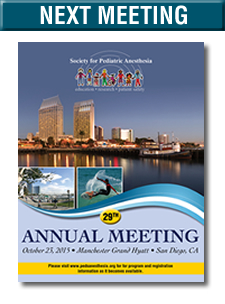spa meeting reviews
Surgical Home
By Karen Dean, MD
Children’s Hospital Colorado
University of Colorado School of Medicine
The second session on Friday was devoted to a discussion of the “Perioperative Surgical Home” (PSH) concept by physician-executive Mike Schweitzer, MD, MBA (Chair, ASA Committee on Future Models of Anesthesia Practice). Dr. Schweitzer’s educational goals were clear. He set out to define PSH, explain why it was needed and what progress had been made so far, and comment on how PSH might be adapted for the pediatric environment. My goal as a reviewer was even simpler – I just could not leave another lecture on PSH stillnot knowing what it means.
I am happy to report that the lecture was enlightening. Perhaps the best way to introduce PSH is to imagine an example. Let’s say that I am an anesthesiologist in a busy surgery center, caring for a patient having a rotator cuff repair. I deliver a balanced general anesthetic with a nerve block for postoperative analgesia, keeping in mind my usual goals to reduce opioid consumption, avoid nausea, and expedite PACU discharge. The patient goes home happy and I congratulate myself and move on to the next patient. Unfortunately, I never know that the patient gets readmitted tomorrow with uncontrolled pain and opioid side effects, resulting in increased healthcare costs and patient dissatisfaction.
This example illustrates the need for PSH. As anesthesiologists, it is easy to define our success based only on the outcomes we can see, such as time to PACU discharge. This is short-sighted, as the intraoperative encounter is only a small part of the surgical encounter as a whole. By taking a broader view, we can work to optimize the entire scope of the patient perioperative experience, improving total health quality, patient experience, and cost of care. We can move towards improving care before, during and after surgery, and we can minimize variation between hospitals in cost-to-treat, readmission rate, and adherence to evidence-based guidelines.
This is the main premise behind the PSH model, which is defined as a “patient-centered, physician-led, interdisciplinary and team-based system of coordinated care for the procedural and surgical patient.” PSH starts with the decision that the patient needs surgery, and extends to 30-90 days after post-surgical discharge. Anesthesiologists can easily be involved in coordinating care throughout the PSH timeframe, perhaps re-purposing existing preoperative care clinics to also follow high-risk patients after discharge.
The PSH concept comes with financial implications. Traditional fee-for-service payment models are gradually being phased out in favor of value-based payment models. The US government’s goal is that by 2018, 90% of all Medicare payments will be based on quality of service, and major insurance companies are following suit.
The PSH Learning Collaborative is a group of 44 healthcare organizations (including many pediatric centers) committed to trying out PSH ahead of the rest. They are working on finding the best healthcare delivery models and payment models, and providing the rest of us with a “tool kit” of advice for implementation when we follow their lead. Their goal is to start with high quality healthcare, and let quality be the change agent for better outcomes and lower costs.
Adopting the PSH concept widely will not be easy, and hospitals will need strong leadership to overcome the natural resistance to change. Dr. Schweitzer advises hospitals to start small – pick one surgeon, one type of surgery, or one phase of surgery and focus efforts there. It is not quite clear how the concept of PSH will meld with the educational mandate of academic centers. If healthcare is moving towards decreased variability in practice, then how will our trainees be exposed to a variety of techniques and ideas? What if the “right” way that we teach today turns out to be the “wrong” way tomorrow, and our trainees lack adaptability? The PSH concept is still a growing idea, not without its flaws, but thanks to Dr. Schweitzer for explaining the idea and its promise.



